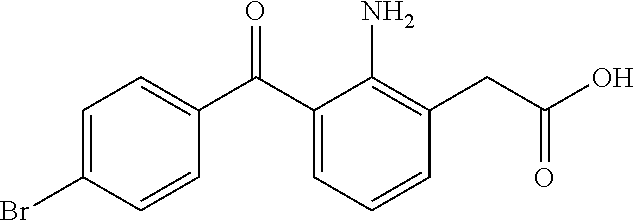Compositions and methods for the treatment of ocular surface allergies
a technology for ocular surface allergies and compositions, applied in the direction of drug compositions, immunological disorders, peptide/protein ingredients, etc., can solve the problems of prior ophthalmic delivery systems for the treatment of ocular surface allergies that have suffered drawbacks, and achieve the effects of facilitating the sustained release of bromfenac, facilitating the in vivo mucosal absorption rate, and reducing the risk of allergic reactions
- Summary
- Abstract
- Description
- Claims
- Application Information
AI Technical Summary
Benefits of technology
Problems solved by technology
Method used
Image
Examples
example 1
[0048]Polycarbophil (Noveon® AA-1) was slowly dispersed into a citrate buffer solution containing dissolved EDTA and sodium chloride at approximately 50% of the final batch size. The resulting dispersion, which had a pH of a bout 3.0 to 3.5, was stirred with an overhead stirrer until visibly well hydrated. The mixture was sterilized by autoclaving at 121° C. for 20 minutes. The pH was then brought up to approximately 4.0 to 4.4 with 2N sodium hydroxide. Bromfenac sodium was dissolved in a mannitol solution containing dissolved benzalkonium chloride and Poloxamer 407 at approximately 20% of the final batch size. The resulting solution was then sterile filtered (0.22 μm filter) in to the polymer dispersion and stirred for 10 minutes. The pH of the bromfenac-polymer dispersion was brought to 8.3 with 2N sodium hydroxide. Sterile make up water was added by sterile filtration to the formulation to final weight and mixed for at least 5 minutes. The formulation was aseptically filled into ...
example 2
[0049]
TABLE 2Composition of Bromfenac Formulations Non-PreservedConcentration (% w / w)ExcipientLow StrengthMid StrengthHigh StrengthBromfenac0.01%0.0250.05Polycarbophil0.910.910.91Citric acid0.20.20.2Sodium citrate0.0250.0250.025Sodium chloride0.10.10.1Poloxamer 4070.20.20.2Mannitol1.01.01.0Boric Acid0.490.490.49Sodium Borate0.510.510.51Sodium hydroxide, 2Nq.s. to pH 8.3q.s. to pH 8.3q.s. to pH 8.3Waterq.s. to 100%q.s. to 100%q.s. to 100%
TABLE 3Compositons with Bromfenac and VasodilatorConcentration (% w / w)ExcipientLow StrengthMid StrengthHigh StrengthBromfenac0.01%0.0250.05ephedrine0.0950.1150.03hydrochloride*naphazoline0.010.020.03hydrochloride*tetrahydrozoline0.010.0250.05hydrochloride*phenylephrine0.080.150.2hydrochloride*Polycarbophil0.910.910.91Citric acid0.20.20.2Sodium citrate0.0250.0250.025Sodium chloride0.10.10.1Poloxamer 4070.20.20.2Mannitol1.01.01.0Boric Acid0.490.490.49Sodium Borate0.510.510.51Sodium hydroxide, 2Nq.s. to pH 8.3q.s. to pH 8.3q.s. to pH 8.3Waterq.s. to 100...
PUM
| Property | Measurement | Unit |
|---|---|---|
| viscosity | aaaaa | aaaaa |
| pH | aaaaa | aaaaa |
| particle size | aaaaa | aaaaa |
Abstract
Description
Claims
Application Information
 Login to View More
Login to View More - R&D
- Intellectual Property
- Life Sciences
- Materials
- Tech Scout
- Unparalleled Data Quality
- Higher Quality Content
- 60% Fewer Hallucinations
Browse by: Latest US Patents, China's latest patents, Technical Efficacy Thesaurus, Application Domain, Technology Topic, Popular Technical Reports.
© 2025 PatSnap. All rights reserved.Legal|Privacy policy|Modern Slavery Act Transparency Statement|Sitemap|About US| Contact US: help@patsnap.com

